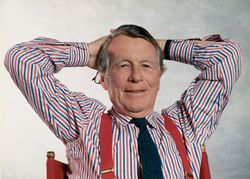
The consumer isn’t a moron; she is your wife.
I don’t know the rules of grammar…If you’re trying to persuade people to do something, or buy something, it seems to me you should use their language, the language they use every day, the language in which they think.
Never stop testing and your advertising will never stop improving.
He built great brands like Hathaway shirts, Schweppes and Dove and started an advertising agency built on his principles. If he were to launch a brand today, I have a feeling David would be a pretty good social media marketer too. His quotes and principles have just as must relevance for social media as advertising.
Here are 20 ways he would (or might) use social media to launch a new brand, today.
- GOGGLE INSIGHTS: Start by looking at the most used words and phrases consumers use when they search because 90% of every purchase decision begins on the internet.
- BLOGHER: Turn to blogging communities like BlogHer to seek out thought leaders in relevant industries and through blog comments solicit their views, maybe win their advocacy. After all, today, the consumer is not only your wife but, if she blogs, a good writer who carries influence.
- COMPANY BLOG: Create a company blog to show the people at the company who manufacture the product are accessible.
- INFOGRAPHICS: Use infographics as a more dynamic form for presentations and stop doing staid power point decks.
- SLIDESHARE: See what are the latest presentations on media, research and technology are. Stay at he leading edge of the agency business.
- FACEBOOK LANDING PAGES: Introduce the value proposition to new users in social media just as you would with an ad.
- FACEBOOK PROMOTIONS THROUGH THE WILDFIRE APP: Drop coupons or run a sweepstakes to fans at the fraction of the cost from the early days of advertising.
- RETAILERS FACEBOOK PAGES: Examine key retailers who have big Facebook Fan bases and see if they will do posts to support the new brand – a win/win situation for the retailer and the brand, especially since fan bases for retailers like Walmart have 9,000,000+ fans.
- TWITTER HASHTAG COMMUNITY: Start a # community on Twitter around the key need the brand meets. Do a regularly scheduled chat once a week to see how consumers speak and think about the brand.
- TWITTER PAGE FOR CUSTOMER SUPPORT: Create a Twitter page to answer consumer questions like Best Buy did with Twelpforce.
- YOU TUBE ANALYTICS: Create a YouTube channel for the commercials and use YouTube Analytics to see how long they watch them and, if there is a drop off, where?
- COMPETITIVE INTELLIGENCE: Listen to the comments and posts on the social networks of competitors and see what their consumers are saying and where they might be opportunities.
- TARGETING TOOLS: Use targeting tools like Openbook, Booshaka and Twitter Search
- SURVEYS: Poll fan bases to gauge consumer satisfaction using available survey apps.
- YELP AND REVIEW SITES: See if reviews are being written and what they say. Maybe even consider doing an ad with some of them.
- SHORT URL’S: Use Short URL’s to track the posts and messaging that draws the most clicks and interest.
- DOWNLOADABLE CONTENT: Use content that can be downloaded or embedded to measure not just interest but involvement.
- SET UP REPORTING AND TRACKING: Make the commitment to identify metrics that are important to track regularly and integrate with other key business tracking measures.
- CROWDSOURCE NEW IDEA PRODUCT EXTENSIONS: Like MyStarbucksIdea, reach out to your community for new product innovations and ideas
- GIVE THANKS TO COMMENTS GOOD AND BAD: Show appreciation for the negative as well as the positive comments and be timely with response. What social media offers to a brand is the opportunity to have a relationship with a person, not a company, and to build trust faster.
I’ve heard David, in his later years, spent less time at the agency and more time at a chateau he owned in France. That’s ok. He could do most of the work from there; that is, if he had an internet connections and some smartphone apps.
Do you think this is how David Ogilvy would use social media if he was still with us today?





Yes, these old principles are still essential, especially for young marketers, to keep in mind, even for the “new media” world. Terrific blog!!
[…] – H2H Marketing David Ogilvy’s quotes are as relevant to social media as to advertising.Via barnraisersllc.com Share this:TwitterFacebookLike this:LikeBe the first to like this post. This entry was posted in […]
Loved the connection to Ogilvy Rob. Good to see that things are going swell.